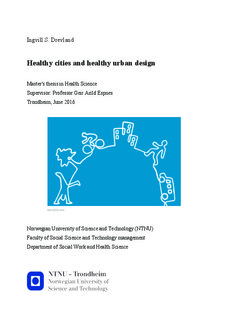| dc.description.abstract | As an occupational therapist, I have always found the interaction between humans, their
environment and their activities interesting, and how the environment can influence what we
do and our occupational patterns is something that fascinates me. As my interest for urban
health and healthy cities has grown during this master program, I have chosen to use the
experience and knowledge I have from my field of expertise and put it in the context of
healthy urban planning. This master’s thesis therefore consists of two articles focusing on
urban health and healthy urban planning. The first article is a review of how the environment
can influence health and well-being of urban dwellers. The second article is based on the
results from the first article, and is a qualitative study focusing on what creates health in the
urban environment, and how this is related to the actual urban design.
Article Ι: Today a great amount of the world population lives in urban areas. As health
essentially is created outside the health sector, the urban environment becomes an important
determinant of health. Thus, it becomes important not only to understand how to develop
healthy urban environments, but also to understand what this entails. This review article
therefore aims to explore how the built environment can influence the health and well-being
of urban dwellers, and what this means for health promoting measures in the urban
environment. The built environment appears to affect health and well-being of urban dwellers
on both the individual and community level. However, in the process of developing healthy
urban environments or health promoting measures in the urban environment, it is important to
understand the different environmental dimensions.
Article ΙΙ: With the rapid urbanization around the world, it is argued that the urban
environment is an important arena for health promotion. The main aim in this study is to
identify what creates health in an urban environment and how this is related to the actual
urban design. This is a phenomenological study that includes in-depth interviews with three
men and five women aged 23-65. Systematic text condensation was used to analyze the
material and three categories were identified as health promoting factors of urban life: (1)
Accessibility, (2) Variation and (3) Flexible social arenas. The study shows how the three
categories are related to the actual urban design and how they can affect health and well-being
of urban dwellers. It is also argued that these three categories are connected to each other and
as a whole might facilitate healthy urban environments, and thus healthy urban dwellers. | nb_NO |
